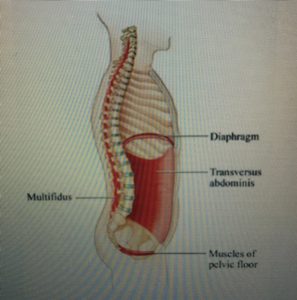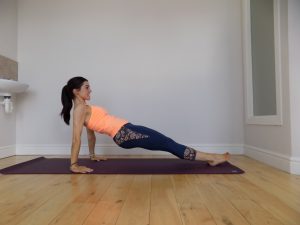Pilates is one of the best forms of treatment for back pain! Why it is effective may be less clear so here we explain why pilates could work for you.
Firstly, we use our backs for almost every single task in daily life therefore it is inevitable that we will experience back pain at some point in our lives. It is suggested that up to 80% of adults will suffer low back pain and around 40% of the population will have back pain in any one-year period (1). That is high figures! And these figures do not take into consideration back injuries sustained through sports or increased exercise demands.
The anatomy & science!
The spine is protected and surrounded by a group of muscles called the core muscles (see image below. (2)). At the front there is the transversus abdominus (TrA) (horizontal around the stomach area), at the back there is the erector spinae muscles that span vertically up the whole spine & multifidus (closer in to the spine), at the top is the diaphragm, and at the bottom are the pelvic floor muscles.

When these muscles are activated/contracted they have a collective response upon each other ie the activation of one will activate the others and produce a corset of support around the spine. Because the spine is made up of numerous small bones (vertebrae) this muscle activation stabilises the spine, providing support and strength throughout. Increased core stability therefore allows the spine to move through these vertebral segments without injury.
When injury occurs
If core stability is deficient, movements such as bending or reaching out away from the body can place extra strain on the smaller muscles and ligaments. This can gradually weaken the corset of support further and over time allow sensitivity to occur at the intervertebral discs and nerves, causing painful symptoms in the lower back and/or legs. Alternatively; unexpected twists, bends, or lifting something heavy can also place sudden force on the spine and if the core was not engaged/activated at this precise moment the spine is left vulnerable and strain can occur to the spine muscles/nerves.
When back pain occurs, the brain quickly recognises this feeling and adaptations occur within your brain to deal with the change in chemicals. The brain’s area (motor cortex) reorganises itself so that the body compensates and adopts a new postural position to deal with the pain. If the pain remains over a longer period of time the brain then perceives this new posture as “normal”, and anything different from this feels abnormal (3).
How pilates can help this
Pilates exercises teach you to initiate movements from YOUR CORE. So they re-train this corset of support to provide tightness, stability, and support to the spinal vertebrae and support the muscles, ligaments and discs. This increased support essentially provides a “scaffolding” to your spine and reduces the force/pressure on the sensitive structures.
Pilates exercises ALSO then stabilise the rest of your body, it is NOT just about the abdominals! These exercises ensure your arms, legs, hips etc are all working efficiently with correct movements, but using the core muscle support to commence the movement. This gives you a strong trunk and also support to all your other joints to provide full body stability.
Re-training of the transversus abdominus muscle in particular has also been shown to cause changes at the brain’s motor cortex and initiate the re-mapping back to normal organisation. This muscle re-training has also been shown to produce greater changes at the motor cortex than strength training alone(4). Perhaps because pilates activates and strengthens these muscles in isolation so you get a better response than other forms of exercise that work muscles globally in larger groups.
If you only work the larger muscle groups you cannot achieve this deep muscle activation, so the muscles that lie close to the spine are not strengthened properly and cannot support the spine in movements.
Of course, once you have re-gained your core support it IS important to then strengthen the rest of your muscle groups too with appropriate strength training. This will provide additional support to your body to ensure every area is strong and protected, therefore able to withstand any changes in force placed upon your body 🙂

Final words!
- Always seek professional help from a Chartered Physiotherapist for your back pain for a proper diagnosis and treatment plan. What works for one person may be different for you.
- Pilates could be a very useful treatment option, either on it’s own or combined with other treatment methods.
- It does not matter how strong you are in the gym or at your sport, if you have a weak core, delayed activation or your core, or poor core endurance- your spine will suffer!
Try these pilates workout videos to get you started at home:
-
- BMJ. 1998. 316; 1356-1359.
- From www.appihealthgroup.com. Matwork level 1 manual.
- J Orthop Sports Phys Ther. 2009. 39(11):791-798.
- Brain. 2008. 131:2161-2171 .
